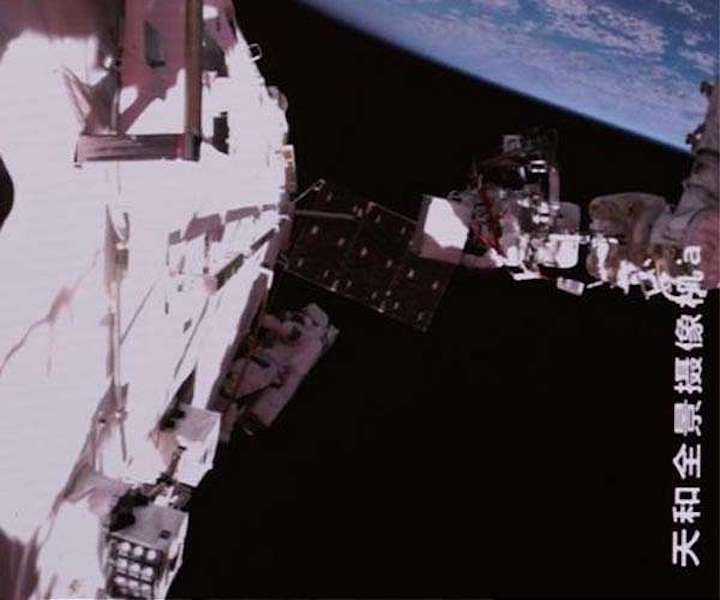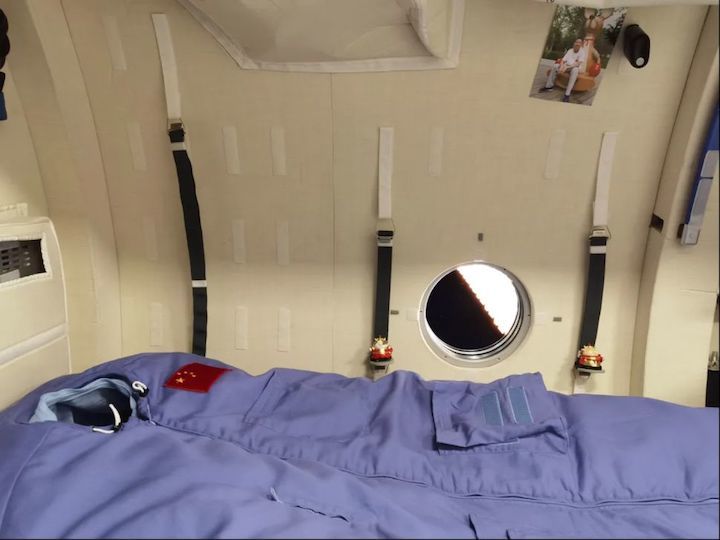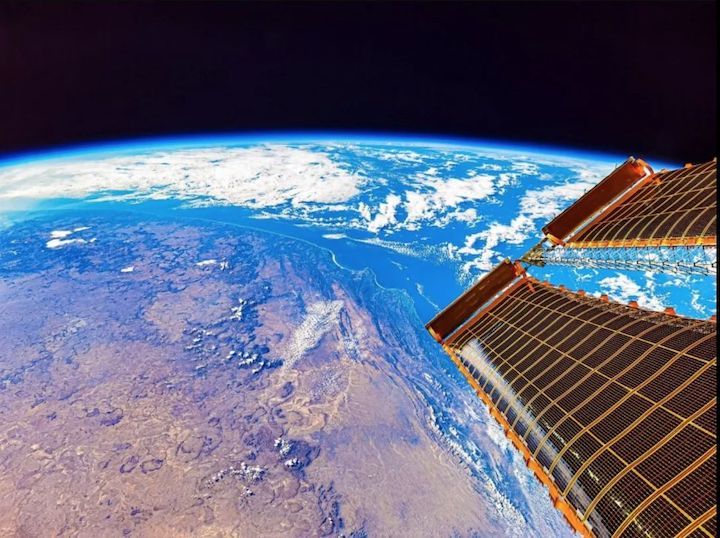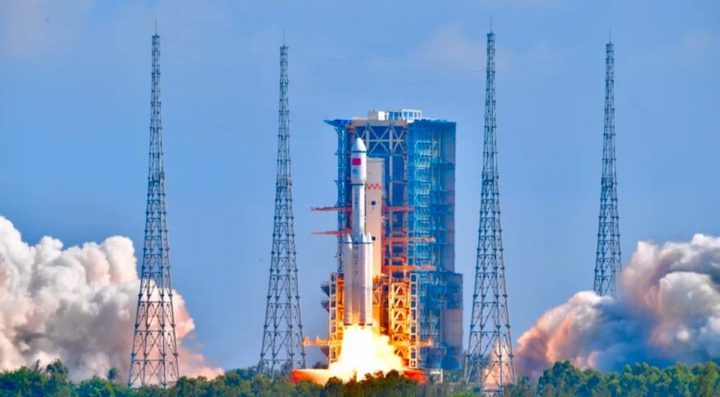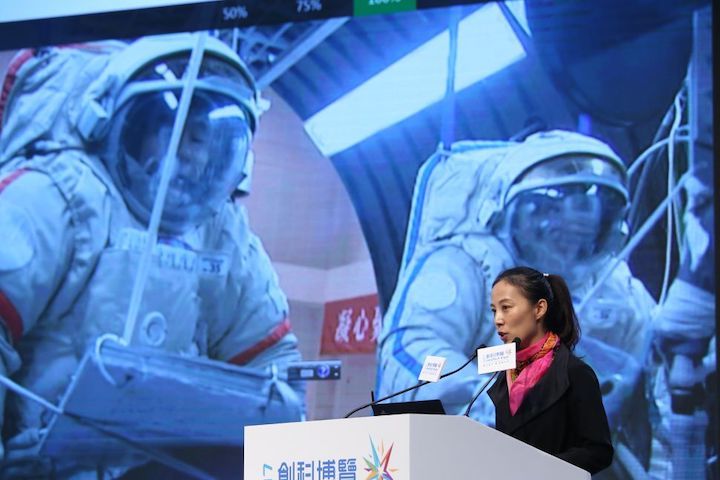18.08.2021
Chinese astronauts to conduct extravehicular activities for second time
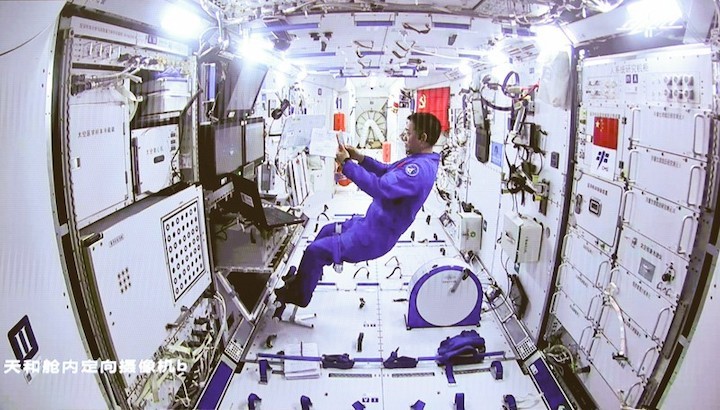
China Manned Space Agency (CMSA) announced on Tuesday that astronauts currently in China's space station core module Tianhe will carry out extravehicular activities (EVAs) for a second time within the next few days.
The three Chinese astronauts have been working and living in orbit for two months. They were sent into space on board the Shenzhou-12 spaceship and entered Tianhe on June 17.
The astronauts are in good condition and the combination of the core module, the spaceship and the Tianzhou-2 cargo craft, is operating stably, the CMSA said.
The Shenzhou-12 space flight is China's seventh crewed mission to space and the first during the construction of the country's space station. It is also the first in nearly five years after the country's last manned mission.
The three astronauts are commander Nie Haisheng, a 56-year-old veteran who participated in the Shenzhou-6 and Shenzhou-10 missions; Liu Boming, 54, who was part of the Shenzhou-7 mission; and Tang Hongbo, 45, who is on his first space mission.
Liu and Tang completed the first EVAs on July 4, accomplishing scheduled tasks including equipment installation and panoramic camera lifting, with close coordination between space and the ground, as well as between the astronauts inside and outside of the spacecraft.
The astronauts have successfully transferred supplies from the cargo craft, put the combination under management, and operated the mechanical arm, said the CMSA.
They also completed space science and technology experiments in multiple fields, said the agency. Enditem
Quelle: Xinhua
----
Update: 21.08.2021
.
Chinese astronauts out of spacecraft for second time extravehicular activities
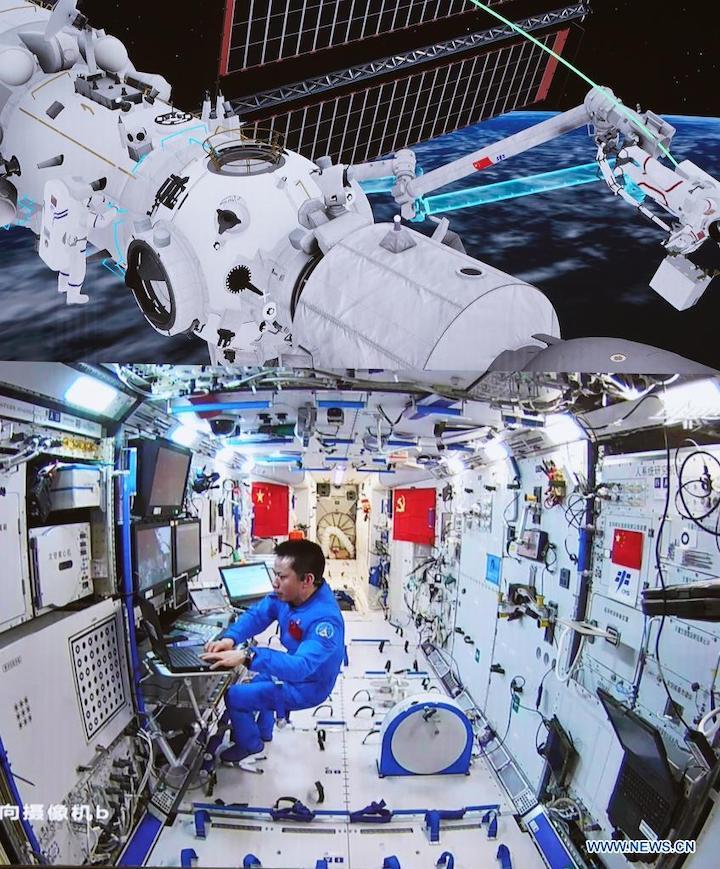
Screen image taken at Beijing Aerospace Control Center on Aug. 20, 2021 shows Chinese astronaut Tang Hongbo working inside the space station core module Tianhe. (Xinhua/Tian Dingyu)
Chinese astronauts Nie Haisheng and Liu Boming had both slipped out of the space station core module Tianhe by 10:12 a.m. (Beijing Time) on Friday to conduct extravehicular activities (EVAs) for a second time, according to the China Manned Space Agency (CMSA).
Nie opened the hatch of Tianhe's node cabin at 8:38 a.m., the CMSA said.
Donning Feitian, new-generation homemade extravehicular mobility unit spacesuits that literally means "flying to space," the two astronauts have completed installing the foot restraints and extravehicular working platform on the mechanical arm, the CMSA said.
They will continue to work together to install other relevant extravehicular equipment with the aid of the mechanical arm, it said.
Astronaut Tang Hongbo has been staying inside Tianhe in cooperation with Nie and Liu for their EVAs.
The three astronauts were sent into space aboard the Shenzhou-12 spaceship on June 17. Liu and Tang completed the first EVAs during the construction of the country's space station on July 4. Enditem
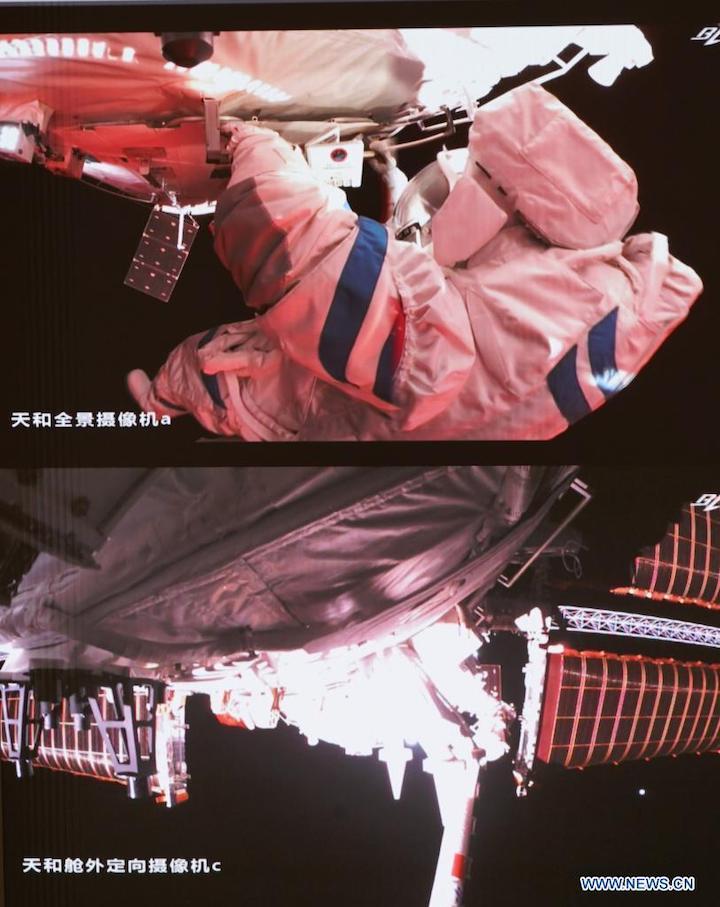
Screen image taken at Beijing Aerospace Control Center on Aug. 20, 2021 shows Chinese astronauts conducting extravehicular activities (EVAs) out of the space station core module Tianhe. (Xinhua/Tian Dingyu)

Screen image taken at Beijing Aerospace Control Center on Aug. 20, 2021 shows Chinese astronauts Nie Haisheng and Liu Boming conducting extravehicular activities (EVAs) out of the space station core module Tianhe. (Xinhua/Tian Dingyu)
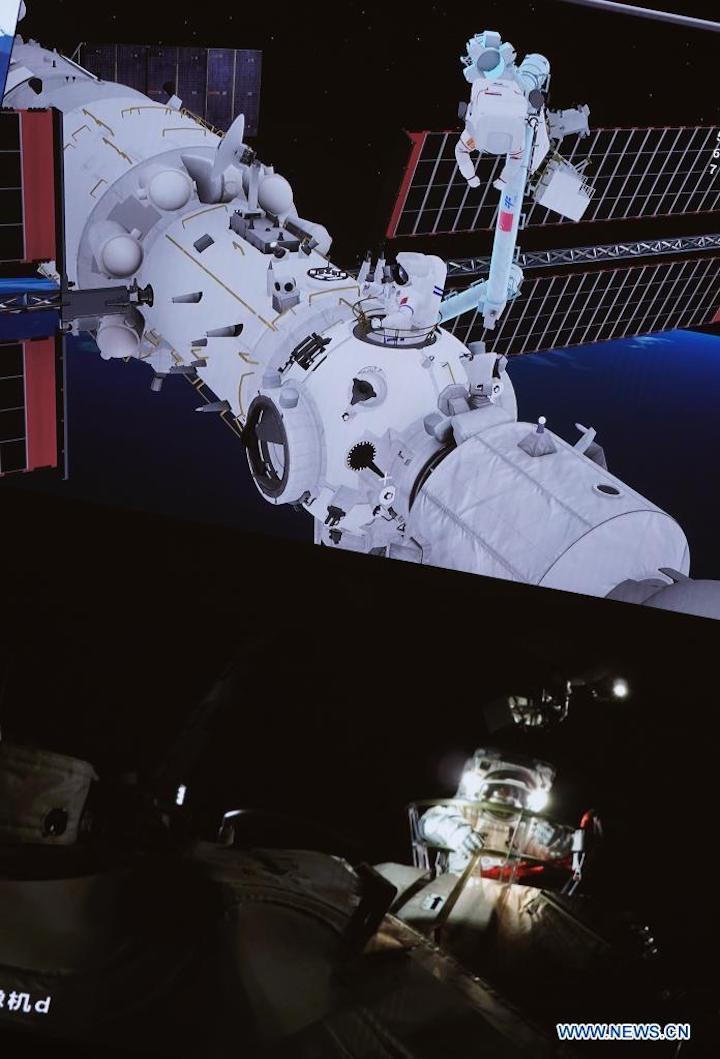
Astronauts conduct second Chinese space station spacewalk
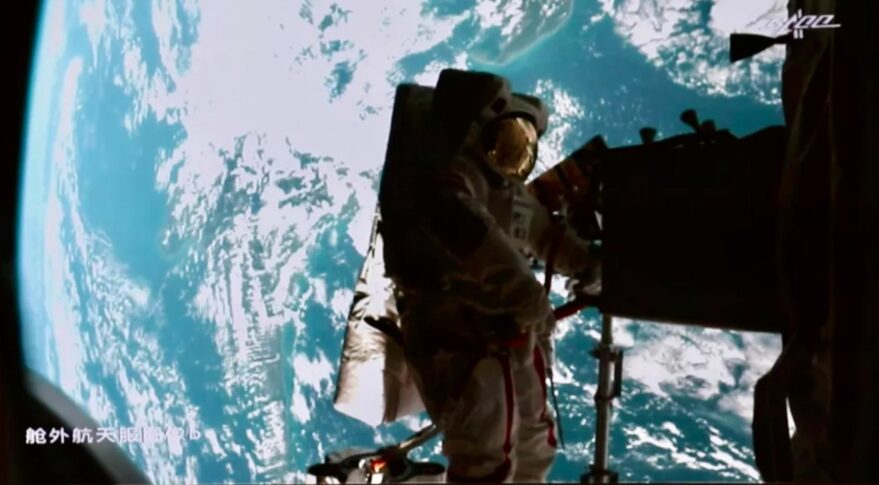
HELSINKI — Chinese astronauts Nie Haisheng and Liu Boming embarked on a second Shenzhou-12 spacewalk late Thursday to carry out work on a space station robotic arm.
Shenzhou-12 mission commander Nie opened the hatch of the Tianhe module at 8:38 p.m. Eastern Aug. 19 to begin a planned near seven-hour extravehicular activity, the China Manned Space Agency (CMSA) said.
The pair, wearing second generation Feitian (“flying to space”) extravehicular mobility suits, completed installing foot restraints and an extravehicular working platform to the large robotic arm. Chinese media outlets streamed footage of the EVA.
The excursion was supported by astronaut Tang Hongbo inside Tianhe, the 16.6-meter-long, 4.2-meter-diameter space station core module which launched April 28.
The EVA also included work on a panoramic camera, installing a toolkit, adding a pump set for the Tianhe thermal control system and other apparatus in preparation for the arrival of two further modules in 2022. The EVA was completed at 2:33 a.m. Friday, around an hour ahead of schedule.
The Shenzhou-12 crew have been aboard Tianhe since June 17. They are expected to return to Earth within a month, ahead of arrival of the Tianzhou-3 cargo supply mission. A first Shenzhou-12 spacewalk was conducted July 3 by Liu Bomng and Tang Hongbo.
The astronauts have carried out a range of activities and experiments in preparation for future missions. Recent work includes installing a refrigeration unit for medical samples, assembly of a space centrifuge, activating a magnetic levitation experiment, blood sampling and testing a hazardous trace gas removal subsystem.
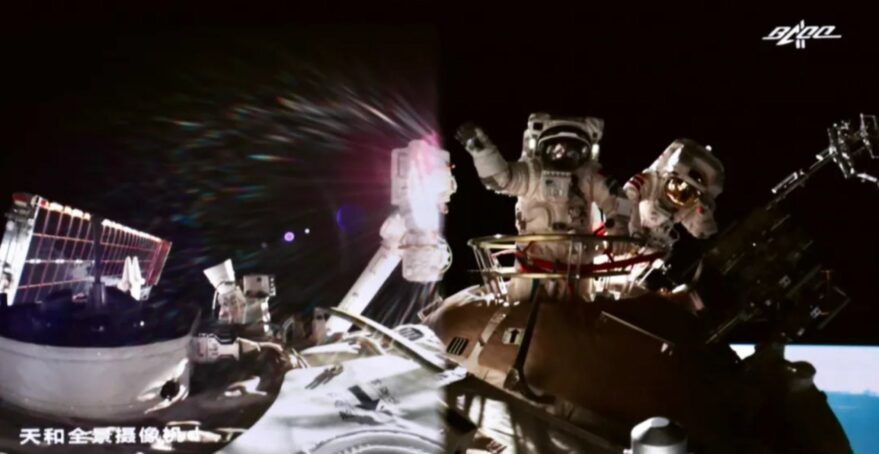
Space station construction plans
The Long March 7 rocket to launch Tianzhou-3 arrived at Wenchang spaceport earlier this week and is expected to launch around September 20. Tianzhou-3 will deliver supplies for the October Shenzhou-13 crewed mission.
Preparations for Shenzhou-13 are underway at Jiuquan, northeast China, where a Long March 2F rocket has been readied in advance in case of need for an emergency launch to Tianhe.
Tianzhou-2, which delivered supplies to Tianhe for Shenzhou-12, is expected to remain docked to the core module beyond the deorbiting of Shenzhou-12. It will then undock from Tianhe’s aft port and dock with the forward docking port and conduct transfer propellant testing with Tianhe.
The 13,000-kilogram liftoff mass Tianzhou-2 will then be used as a test unit for the robotic arm to manipulate modules as part of space station construction. Tianhe will be joined in orbit by two experiment-hosting modules, named Mengtian and Wentian, in 2022.
A day ahead of the spacewalk CMSA released orbital parameters for Tianhe of 379.7 by 396.85 kilometers with an inclination of 41.35 degrees and a speed of 7.68 kilometers per second.
Yang Yanbo, deputy commander of the Shenzhou-12 mission at the Beijing Aerospace Control Center, told Chinese media that teams on the ground are monitoring the space environment and are ready to conduct collision avoidance maneuvers.
Shenzhou-12 is the third of an intensive series of 11 missions for construction of the three-module Chinese space station. Named Tiangong, the overall complex is planned to be completed by the end of 2022.
Tiangong will be joined in orbit by Xuntian, an optical Hubble-class space telescope, around 2024. The Chinese space station could also be expanded from three to six modules if main phase construction proceeds as planned.
Quelle: SN
----
Update: 23.08.2021
.
Chinese astronauts complete second spacewalk outside space station
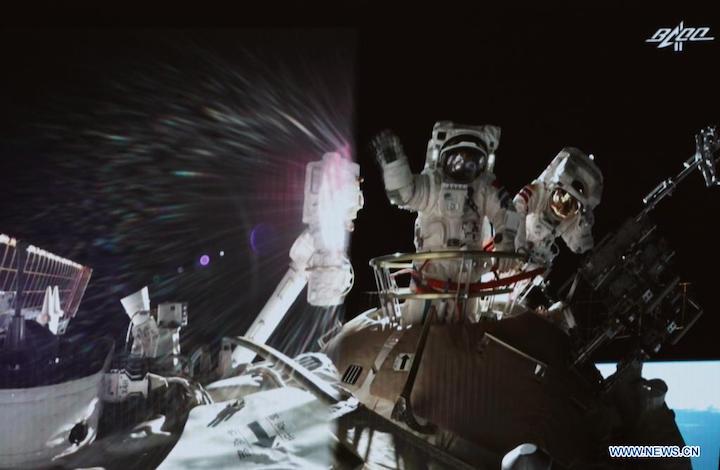
Chinese astronauts Nie Haisheng and Liu Boming accomplished a nearly six-hour spacewalk Friday outside the core module of the country’s new space station, installing a coolant pump and lifting a panoramic camera on the exterior of the complex.
Nie and Liu exited the airlock of the Tianhe core module at 8:38 p.m. EDT Thursday (0038 GMT Friday), according to the China Manned Space Agency.
The two astronauts completed their planned tasks supporting the assembly of the Tiangong space station, Chinese officials said.
One of the highlights of the spacewalk was the the installation of a backup “extended pump set” to help flow liquid coolant through a thermal control system loop regulating temperatures inside the space station. The coolant dissipates heat generated by equipment inside the outpost, and helps ensure steady and comfortable temperatures throughout the station.
Nie and Liu accomplished four steps to complete mechanical and fluid connections with the new pump, the China Manned Space Agency said.
During their spacewalk, the astronauts moved around the exterior of the Tianhe module with the aid of a robotic arm.
The astronauts also raised a panoramic camera outside the station re-entering the Tianhe module at 2:33 a.m. EDT (0633 GMT), completing a 5-hour, 55-minute spacewalk.
Tang Hongbo, the third space station crew member, assisted the spacewalker from inside the Tianhe core module.
The astronauts wore Chinese-made Feitian spacesuits for the spacewalk, which followed a nearly seven-hour excursion July 4 by Liu and Tang. During that spacewalk — the first conducted from the new Chinese space station — astronauts installed foot restraints, a work platform, and a camera outside the Tianhe module.
The spacewalk completed Friday was the third in the history of China’s space program.
China’s first spacewalk was accomplished on the Shenzhou 7 mission in 2008. On that flight, Liu and crewmate Zhai Zhigang briefly exited the hatch to the Shenzhou 7 spacecraft and waived a Chinese flag for a television audience.
The three-man station crew launched June 16 on China’s Shenzhou 12 spacecraft, beginning a planned three-month expedition. The astronauts are the first residents aboard China’s space station.
Assembly of the Tiangong station began in April with the launch of the Tianhe core module on a heavy-lift Long March 5B rocket. China launched a Tianzhou cargo ship to dock with the Tianhe module in May, followed by the arrival of the first Shenzhou crew ship in June.
The Shenzhou 12 astronauts are in the home stretch of their mission. Before returning to Earth in mid-September, the crew will perform circumnavigation and radial rendezvous test with their crew capsule, CMSA said.
A new Tianzhou supply freighter is scheduled to launch to the space station on a Long March 7 rocket in September, followed by the launch and docking of the next space station crew on the Shenzhou 13 spacecraft in October.
Chinese astronauts Nie Haisheng and Liu Boming completed extravehicular activities (EVAs) for the second time during the construction of the space station on Aug 20. They installed extravehicular extended pump sets and lifted the panoramic camera in their EVAs.
The newly installed extravehicular extended pump sets will play a key role in ensuring the in-orbit operation of China's space station for no less than 15 years, according to the China Academy of Space Technology (CAST).
Extravehicular "heart"
Developed by the CAST, the extended pump sets are called the "heart" of the fluid loop, which is a core part of the space station's thermal control system.
"Like a heart providing power for blood flow and sending blood to all parts of a body, the pump sets keep the special liquid circulating stably in the loop," said Han Haiying, a CAST designer of the thermal control system.
Without the protection of the atmosphere, the surface temperature of the space station can reach more than 150 degrees Celsius under the sunlight. While in the dark, its surface temperature can drop to lower than minus 100 degrees Celsius.
In this harsh space environment, the thermal control system is crucial in ensuring the normal operation of the space station's equipment and comfortable living conditions for the astronauts.
The fluid loop evenly covers the key parts of the space station. By circulating the special liquid in the loop, it is capable of collecting heat generated by onboard equipment and astronauts for cooling and bring the heat to relevant devices and structures for heat supplementation, according to Zheng Hongyang, a CAST engineer in charge of the fluid loop of the thermal control system.
It can also help precisely control the temperatures of various "rooms" in the space station, said Zheng.
"Always operating at a high speed, the liquid loop pumps have a limited service life and must be repairable and replaceable," Han said.
The thermal control team thus created multiple "hearts" for both inside and outside the cabin for the fluid loop, so as to empower the system with ultra-long operation capability.
Simple but important move
In the space environment, astronauts wearing spacesuits are restricted in their movements. A simple action, such as turning a screw, could cost them a lot of energy and time.
The CAST team did their best to simplify the procedure of installing the extended pump sets, making it a four-step process.
The astronauts need to hook and lock the pump sets to the outer wall of the space station core module Tianhe, and then connect the electric circuit as well as the liquid circuit.
The newly completed EVAs not only verified the technology of installing pump sets in orbit but also laid a good foundation for the following construction of the space station and stable operation of the station for up to 15 years, according to the CAST.
The three Chinese astronauts were sent into space onboard the Shenzhou-12 spaceship and entered Tianhe on June 17. Astronauts Liu Boming and Tang Hongbo completed the first EVAs on July 4.
The Shenzhou-12 spaceship crew will continue to carry out scientific and technological space experiments before their planned return in the middle of September.
Quelle: SD
----
Update: 16.09.2021
.
China's Shenzhou 12 astronauts send back stunning images of Earth (photos)
Tianzhou-3 cargo craft launches to the Chinese Space Station
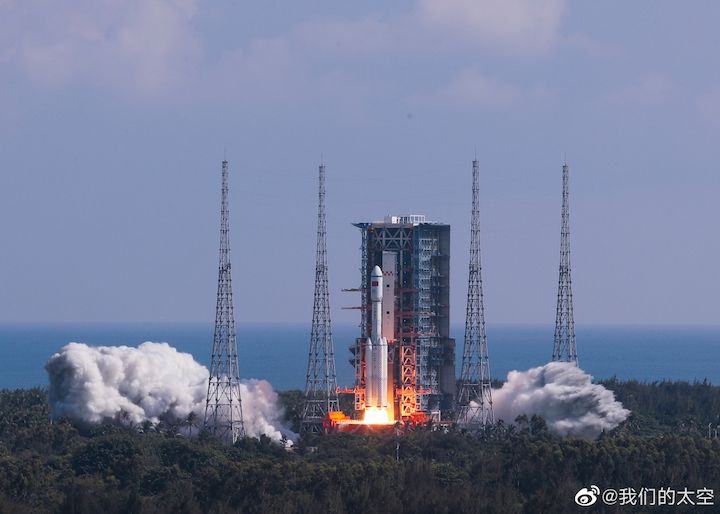
China successfully launched a Long March 7 from the Wenchang Satellite Launch Center at 07:10 UTC (3:10 PM Beijing time), beginning its journey to the Chinese Space Station. The spacecraft then docked to the station just under seven hours later.
This launch of the Tianzhou-3 spacecraft comes days after the successful return of the Shenzhou-12 crew, who landed on September 17. Nie Haisheng, Liu Boming, and Tang Hongbo spent 93 days in space and landed in the Gobi Desert, located in Inner Mongolia near the town of Dongfeng.
The Tianzhou-3 spacecraft brings 5.6 tons of supplies up to the Tianhe core module of the Chinese Space Station (CSS). Some of these supplies include propellant for the station, consumables, and one EVA suit. These supplies will be used by the Shenzhou-13 crew, who are scheduled to launch to the station on a Long March 2F/G from the Jiuquan Satellite Launch Center on October 13.
The spacecraft
Tianzhou-3 is the third Tianzhou spacecraft and the second to fly to the new Chinese Space Station. The spacecraft is similar to the retired European Automated Transfer Vehicle, American Cygnus, and Russian Progress vehicles, as it is used to bring up supplies to the station and is then disposed of in the atmosphere, full of trash.
Tianzhou means “heavenly ship” in Chinese.
The spacecraft is derived from the Tiangong-1 space station, which was China’s first space station. Tiangong-1 orbited the planet from 2011 to 2018 and was visited by two crewed spacecraft, Shenzhou-9, and Shenzhou-10.

The mission patch for the Tianzhou-3 mission
The Tianzhou spacecraft is made up of two main components, the service module, and the cargo module. The service module, which is 3.3 meters long, contains the propulsion and power systems.
Like Tiangong-1, the Tianzhou resupply spacecraft is equipped with two solar panels (on the service module), but Tianzhou only has three-segmented panels, whereas Tiangong-1 had four-segmented panels.
The service module is five meters in length and has a pressurized cargo area. The Tianzhou spacecraft is equipped with a docking apparatus similar to the Russian Androgynous Peripheral Attach System (APAS).
Just like the Russian Progress spacecraft, Tianzhou is able to transfer fuel from the module to the station.
The first launch of the type, Tianzhou-1, launched on April 20, 2017, on a Long March 7 from Wenchang. Two days later, Tianzhou-1 docked at the Tiangong-2 space station. While docked, the spacecraft demonstrated on-orbit refueling capabilities. A second docking also occurred.
After three months of free-flight, Tianzhou-1 reentered the atmosphere on September 22, 2017.
Tianzhou-2 launched on May 29, and docked to the aft port on the Tianhe core module later that day, becoming the first vehicle to dock to the new Chinese Space Station.
Supplies on the spacecraft supplied the crew of Shenzhou-12, who arrived at the station on June 17. On September 29, the Tianzhou-2 spacecraft undocked from the aft port on Tianhe and relocated to the forward port.
The rocket
The Long March/Chang Zheng 7 rocket is one of China’s newest rockets and does not use hypergolic propellants found in many other Chinese launch vehicles.
The first stage has two YF-100 engines, which run on RP-1 Kerosene and Liquid Oxygen (LOX). The four side boosters on the Long March 7 each have one YF-100 engine.
The YF-100 runs oxidizer-rich and operates in the staged combustion cycle. The engine is also used on the Long March 5 and the Long March 6.
The second stage on the Long March 7 has four YF-115 engines.
The first launch of the Long March 7 occurred on June 25, 2016, and every single launch of the vehicle has occurred from Wenchang. The vehicle has had one failure, which occurred on March 16, 2020.
Tianzhou-3 launch campaign
In August, the Long March 7 rocket was shipped to Wenchang. Once at China’s Hainan launch site, the launch vehicle was assembled vertically in an integration facility near the launch pad.

The launch vehicle rolled out to the pad on September 16
On September 16, Tianzhou-3 was rolled out to LC-201 at Wenchang, atop the Long March 7 launch vehicle. Once at the pad, the rocket was enclosed by three gates on the fixed service structure.
As the countdown continued, LOX and RP-1 loading on the launch vehicle began. At T-3 hours, the upper-level gate opened, exposing the payload fairing section of the launch vehicle. An hour before launch, the lower-level gate was opened, exposing the engine section of the Long March 7. At the T-45 minute mark, the middle gate was opened.
Prior to engine ignition, the water suppression system at the pad was turned on, and then the six YF-100 engines on the core stage and the boosters ignited. At T-0, the Long March 7 lifted off from Wenchang.
Soon after liftoff, the launch vehicle rolled to the proper launch azimuth to take the Tianzhou-3 spacecraft to the proper 41.6-degree inclined orbit. As the vehicle headed downrange of Hainan Island, the vehicle traveled over the South China Sea and east of the Paracel Islands.

The Long March 7 lifts off from LC-201 at the Wenchang Satellite Launch Center
After the four side boosters were depleted of fuel, the YF-100 engines shut down and the boosters separated from the core stage of the Long March 7. Soon after, the core stage shut down, and the second stage separated. Then, the four YF-115 engines on the second stage ignited.
The launch vehicle passed over the Philippines, just southwest of the capital of Manila.
The second stage inserted the Tianzhou-3 spacecraft into an initial orbit of around 200 x 332 kilometers. Tianzhou-3 then deployed both solar arrays and the communications antenna. The spacecraft then spent around 6.5 hours raising its orbit for rendezvous with the Tianhe core module.
The Tianzhou-3 spacecraft successfully docked to the aft port on the Tianhe core module at 14:08 UTC.
Quelle: NS
+++
China's cargo craft docks with space station core module

Screen image captured at Beijing Aerospace Control Center on Sept. 20, 2021 shows China's cargo spacecraft Tianzhou-3 docking with the space station core module Tianhe.
China's cargo spacecraft Tianzhou-3, carrying supplies for the upcoming Shenzhou-13 crewed mission, successfully docked with the space station core module Tianhe on Monday, according to the China Manned Space Agency (CMSA).
At 10:08 p.m. (Beijing Time), Tianzhou-3 completed a computer-orchestrated rendezvous and docking at the rear docking port of the Tianhe core module. The whole process took approximately 6.5 hours, the CMSA said.
The Long March-7 Y4 rocket, carrying Tianzhou-3, blasted off at 3:10 p.m. from the Wenchang Spacecraft Launch Site in the southern island province of Hainan. After 597 seconds, Tianzhou-3 separated from the rocket and entered its designated orbit. At 3:22 p.m., the solar panels of Tianzhou-3 unfolded and began working properly.
The CMSA declared the launch a complete success.
On Sept. 18, the Tianzhou-2 cargo craft separated from the rear docking port of Tianhe and docked with its front docking port.
Following Tianzhou-3's docking, the two cargo crafts are docked at the two ends of the Tianhe core module to form a linear shape, waiting for the arrival of Shenzhou-13 crew members.
Monday's launch is the 20th mission of China's manned space programs and the 389th mission of the Long March rocket series.
Zhong Wen'an, chief engineer at the Xichang Satellite Launch Center, said that the Tianzhou-3 mission is the second flight of China's space station cargo transportation system, composed of the Tianzhou spacecraft and the Long March-7 rockets. The mission is key to connecting the preceding verification of key technologies and the following in-orbit construction.
As the ancient Chinese said, to carry out an important task, supplies like rations and forage should go ahead of troops and horses. During the construction of the space station, cargo spaceships will always be launched ahead of crewed missions.
"We will transport support materials, necessary spare parts and equipment first, and then our crew," said CMSA Director Hao Chun.
Tianzhou-3 carries nearly 6 tonnes of goods and materials, including living supplies for the astronauts, one extravehicular space suit for back-up, supplies for extravehicular activities, space station platform materials, payloads and propellants.
The cargo can ensure sufficient food and drinking water for three astronauts to remain in orbit for six months. While Tianzhou-2 had two tonnes of propellant on board, Tianzhou-3 cancelled four propellant storage tanks and carried only 750 kg of propellant to deliver more supplies for the Shenzhou-13 crew.
The color of the packages has been updated to help astronauts identify the contents. The packages on Tianzhou-2 featured markings and QR codes to identify the contents, but as the packaging was all beige, they were a little hard for astronauts to sort and organize. On Tianzhou-3, the supplies are packaged in different colors and with a QR code.
Feng Yong is the chief director of the Tianzhou-3 cargo craft at the China Academy of Space Technology (CAST). He said that Tianzhou-3 carries gas cylinders, the internal pressure can reach 300 times atmospheric pressure. Tanks of this sort containing oxygen can supply astronauts for long periods.
Meanwhile, the cargo freighter also carries water bags made of light and soft materials. The design ensures the safety of drinking water, but also allows for the organized storage of empty water bags.
Wang Ran, a CAST designer for Tianzhou-3, said that most goods carried by Tianzhou-3 were loaded in standard packages. The packages have good mechanical bearing properties and are also antibacterial, mold proof, flame proof and have no harmful gas volatilization.
Wang said the Tianzhou cargo packaging materials make use of a unique ingredient extracted from crab shells.
Following the Tianzhou-3 mission, the Shenzhou-13 manned spaceship will be launched to dock with the core module Tianhe, and three astronauts will then begin their six-month stay in orbit.
China plans to complete the verification of key technologies and the in-orbit construction of the space station through multiple launches within two years.
Five launch missions are planned for this year, namely the launch of the Tianhe core module, Tianzhou-2 cargo ship, Shenzhou-12 crewed mission, Tianzhou-3 cargo ship and the upcoming Shenzhou-13 crewed mission.
Six more missions will come in 2022, including the launch of the Wentian and Mengtian lab modules, two cargo spacecraft and two crewed spaceships, to complete the construction of the space station. Enditem
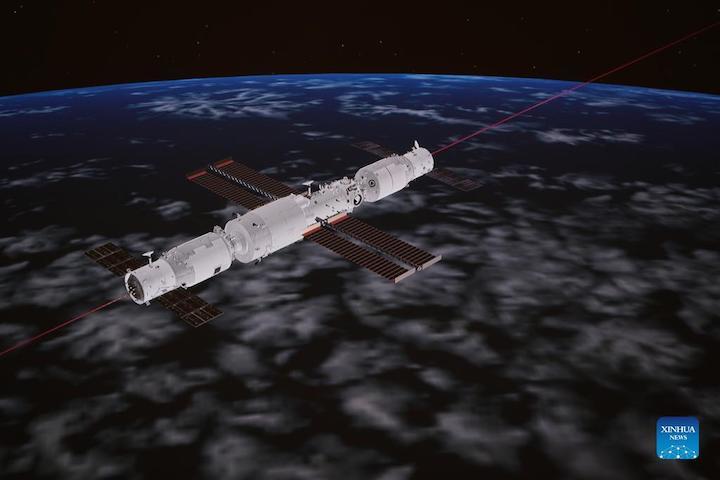
Screen image captured at Beijing Aerospace Control Center on Sept. 20, 2021 shows China's cargo spacecraft Tianzhou-3 docking with the space station core module Tianhe.
Quelle: Xinhua
----
Update: 26.09.2021
.
China eyes sending 1st female astronaut to new space station

